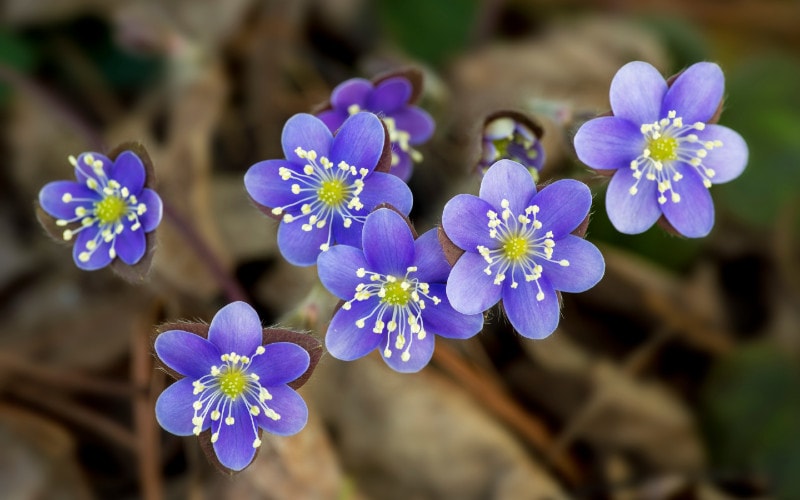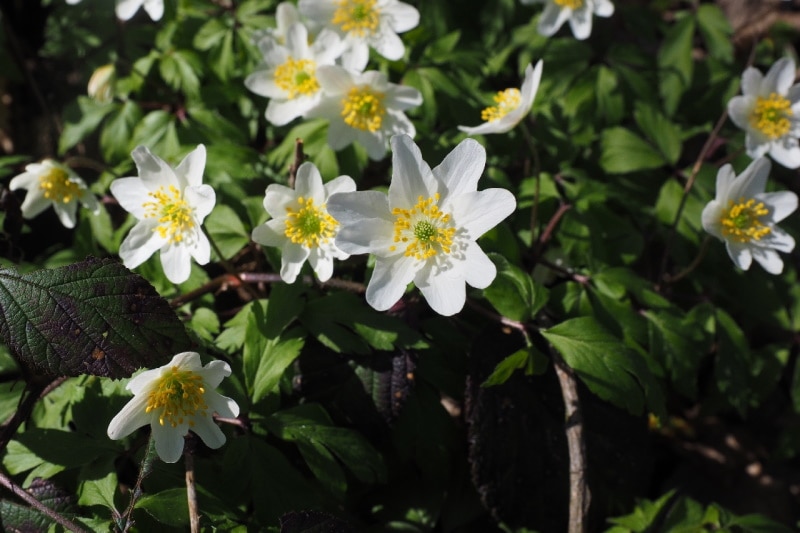15 Wildflowers Native to New York (Identification Guide With Pictures)
-
Jeff Weishaupt
- Last updated:

While New York might be more commonly known for its skyscrapers, bustling city streets, and cultural attractions, there is also a unique natural beauty to the Empire State.
Wildflowers are plentiful in New York. Some common families include orchids, roses, gentians, and asters. Below are 15 of the most common wildflowers native to New York with pictures for identification.
The 15 Wildflowers in New York
New York’s climate facilitates the growth of a rich diversity of wildflowers. Here are some of the most common and beloved wildflowers that grow in New York:
1. Tall Hairy Agrimony
| Scientific Name: | Agrimonia gryposepala |
| Native Family: | Rosaceae – Rose family |
| Other Names: | Tall Agrimony, Common Agrimony, Tall Hairy Groovebur |
A member of the Rosaceae family, the tall hairy agrimony is a perennial wildflower native to New York. Its pale yellow flowers appear in the late summer months when other wildflowers have started to die back. The stems feature long, silky hairs that give the plant its name.
Its glandular hairs cover the sepals, bracts, stalks, and hypanthium. The flower prefers partial shade and moist to dry soil. It grows in thickets, banks, swamps, fields, and woodland edges.
2. Hop Clover
| Scientific Name: | Medicago lupulina |
| Native Family: | Fabaceae – Pea family |
| Other Names: | Black Medic, Black Hay |
Hop clovers are biennial or winter annual plants. They are members of the pea family, which includes clovers, peas, beans, and vetches.
The plants grow best in full sun and moist, well-drained soil. Hop clovers are hardy in zones 3 to 8. They have trifoliate leaves arranged in rosettes and divided into three leaflets. The leaves are usually green but may also be reddish-purple or yellow.
The flowers of hop clover are small and yellow, appearing in late spring to early summer. The plants produce fruits, which are called loments, and contain several seeds. They are similar in size and shape to beans, but they have a hard outer shell.
3. Round-lobed Hepatica

| Scientific Name: | Anemone americana |
| Native Family: | Ranunculaceae – Buttercup family |
| Other Names: | Liverleaf |
The round-lobed hepatica is a small, perennial herbaceous plant in the buttercup family. It grows up to 12 inches tall and features a basal rosette of three-lobed leaves. The flowers bloom in early spring, typically ranging in color from white, pink, purple, and blue.
It can often be found in open woods with thick leaf litter or near rocky outcroppings. Meanwhile, it prefers moist, loamy soil and full to partial sun.
4. Wood Anemone
| Scientific Name: | Anemone quinquefolia |
| Native Family: | Ranunculaceae – Buttercup family |
| Other Names: | Nightcaps, Twoleaf Anemone |
Also known as nightcaps, the wood anemone is a perennial wildflower. It blooms early and can often be seen in woodlands, meadows, and hedgerows. The woodland anemone has a delicate cup-like white flower with six petals.
It grows from a horizontal rhizome, and its leaves are divided into three leaflets. The anemone plant is quite hardy and can tolerate low temperatures for brief periods of time. It is often found growing along the edges of trails and pathways in dappled sunlight or partial shade.
5. Hairy White Oldfield Aster
| Scientific Name: | Symphyotrichum pilosum |
| Native Family: | Asteraceae – Aster family |
| Other Names: | Frost Aster, White Heath Aster, Downy Aster |
The white heath aster or the hairy white Oldfield aster has unique, silvery-white foliage that distinguishes it from other asters. The stems of these small white flowers are covered in tiny hairs and reach up to two feet tall.
The white flowers produce abundant nectar and pollen, making them attractive to beneficial pollinators such as bees, butterflies, and hummingbirds. Meanwhile, the small white flowers are fragrant and can be used in cut flower arrangements or bouquets.
6. Whorled Aster
| Scientific Name: | Oclemena acuminata |
| Native Family: | Asteraceae – Aster family |
| Other Names: | Mountain Aster, Sharp-leaved Aster |
The whorled aster is a perennial herbaceous plant native to parts of the eastern United States and Canada. It typically grows to 1–2 feet in height and has a few branching stems with alternate, linear leaves.
The flowers are small, white or light blue, and daisy-like with a yellow center. They bloom from June to August in clusters near the top of the stem. The whorled aster is found in moist, open habitats such as meadows, pastures, and roadsides.
7. Balloon Vine

| Scientific Name: | Cardiospermum halicacabum |
| Native Family: | Sapindaceae – Soapberry family |
| Other Names: | Love in a Puff, Heartseed |
Balloon vine, also called Love in a Puff, can grow to 10 feet long and produce puffy, heart-shaped seed pods in yellow and purple. These hardy vines grow best in full sun and well-drained soil and need plenty of water during the growing season.
The leaves are deep green with toothed edges and grow in three-parted leaflets. Meanwhile, the flowers are small and white, with five petals. The plant climbs on fences with tendrils.
8. White Baneberry

| Scientific Name: | Actaea pachypoda |
| Native Family: | Ranunculaceae – Buttercup family |
| Other Names: | Doll’s Eyes |
White baneberry is a perennial plant that grows in clusters of white berries and has a single white flower. The leaves are two to three inches long and are divided into three leaflets.
The flowers are white and have five petals each. The berries are round and usually 2–4 millimeters in diameter. However, they’re not edible since they contain a toxin that can be harmful if ingested. Eating large quantities of these berries can result in respiratory paralysis or cardiac arrest.
9. Southern Barren Strawberry

| Scientific Name: | Geum donianum |
| Native Family: | Rosaceae – Rose family |
| Other Names: | Appalachian Barren Strawberry, Small-petaled Barren Strawberry |
The southern barren strawberry belongs to the plant family Rosaceae and is native to the southeastern United States. It’s a low-growing, evergreen groundcover that thrives in sandy soils and grows in part sun.
The leaves are dark green to greenish-gray, elliptic to oblong in shape, and have a thick, leathery texture. The flowers have five white petals and yellow anthers that bloom in late spring.
10. Beechdrops
| Scientific Name: | Epifagus virginiana |
| Native Family: | Orobanchaceae – Broom-rape family |
| Other Names: | Cancer Drops, Clapwort, Virginia Broomrape |
Beechdrops or clapworts are a small flowering plant that grows in large colonies on the trunks and branches of American beech trees. The plants can reach up to 8 inches and have small white flowers that open in late summer or early fall.
Beechdrops extract nourishment from the beech tree and can survive long periods of drought or other environmental stressors. They can out-compete other plant species when the environment is favorable, creating large colonies on beech trees.
The leaves of the beechdrops are often eaten by deer, and the plants have been used to make medicines for various ailments.
11. Sessile-leaf Bellwort

| Scientific Name: | Uvularia sessilifolia |
| Native Family: | Liliaceae – Lily family |
| Other Names: | Wild Oats |
Sessile-leaf bellworts are yellow blossoms found primarily in moist deciduous woodlands of the eastern United States. But they are also common in parts of North America, Europe, and Asia.
They are members of the lily family, including many other garden plants like daylilies and hostas. Bellworts can reach up to a foot high and are most common in May or June when they’re in full bloom.
The flowers have wide green leaves with serrated edges that look like teeth. The yellow flowers are bell-shaped with six petals and have a sweet scent.
12. Wild Bergamot

| Scientific Name: | Monarda fistulosa |
| Native Family: | Lamiaceae – Mint family |
| Other Names: | Bee Balm |
Belonging to the mint family, the wild bergamot flower is an excellent source of nectar for honeybees and other pollinators. Its blossom is also a sweet treat as it produces a pleasant, minty aroma.
The plant grows in dense clumps, and its foliage is covered with minty-scented leaves. Its flowers are purplish-pink, and they open in the early summer. The wild bergamot is hardy and easily adapts to a variety of soil and weather conditions.
13. Squirrel Corn
| Scientific Name: | Dicentra canadensis |
| Native Family: | Fumariaceae – Fumitory family |
| Other Names: | Wild turkey-pea, Turkey Corn, Colicweed |
The squirrel corn wildflowers are a great addition to any garden, with their bright white blossoms and their hardy nature. These flowers grow on a pedicel with a raceme or unbranched stalk.
The flowers are usually white but may also be pink or yellow. They have a dense look, with the flowers tightly packed on the pedicel. The flowers spread out as they age, giving the corn a more open look.
14. Scarlet Bergamot

| Scientific Name: | Monarda didyma |
| Native Family: | Lamiaceae – Mint family |
| Other Names: | Scarlet Beebalm, Oswego Tea |
The Scarlet Bergamot is among the most widely distributed wildflowers in North America. It is a member of the mint family and has bright red-orange or pink flowers that bloom from June to September. The center of the flower is a large, dark-colored seed cluster.
The Scarlet Bergamot is known for its hardiness and can be found in fields, meadows, and along roadsides. It is often used as a nectar source for bees, butterflies, and hummingbirds. Plus, it makes a great addition to gardens as it is drought-tolerant and requires little maintenance.
15. Buttonbush
| Scientific Name: | Cephalanthus occidentalis |
| Native Family: | Rubiaceae – Madder family |
| Other Names: | Common Buttonbush, Button Ball, Riverbush, Honey-bells, Button Willow |
Buttonbush is a wildflower that blooms in the late summer and fall, typically between June and October. It is a deciduous shrub with showy round clusters of white flowers that are beloved by butterflies and bees.
The fragrant blooms are followed by seed pods which can be used in dried arrangements or for making wreaths. It is a fast-growing, versatile shrub that can be used in water gardens as a border plant or to create wildlife.
Conclusion
New York has a vast variety of wildflowers, from orchids to roses. With a little bit of research and exploration, you can find an abundance of wildflowers in New York’s parks, trails, and even in your own backyard.
Wildflowers are a great way to add a touch of nature and beauty to any outdoor space. Some of them also have medicinal and culinary uses. However, avoid eating berries or other fruits of unknown plants to avoid any potential health hazards, so be sure you know what you’re dealing with before eating any wild plants!
Featured Image Credit: Jumpstory
Contents


